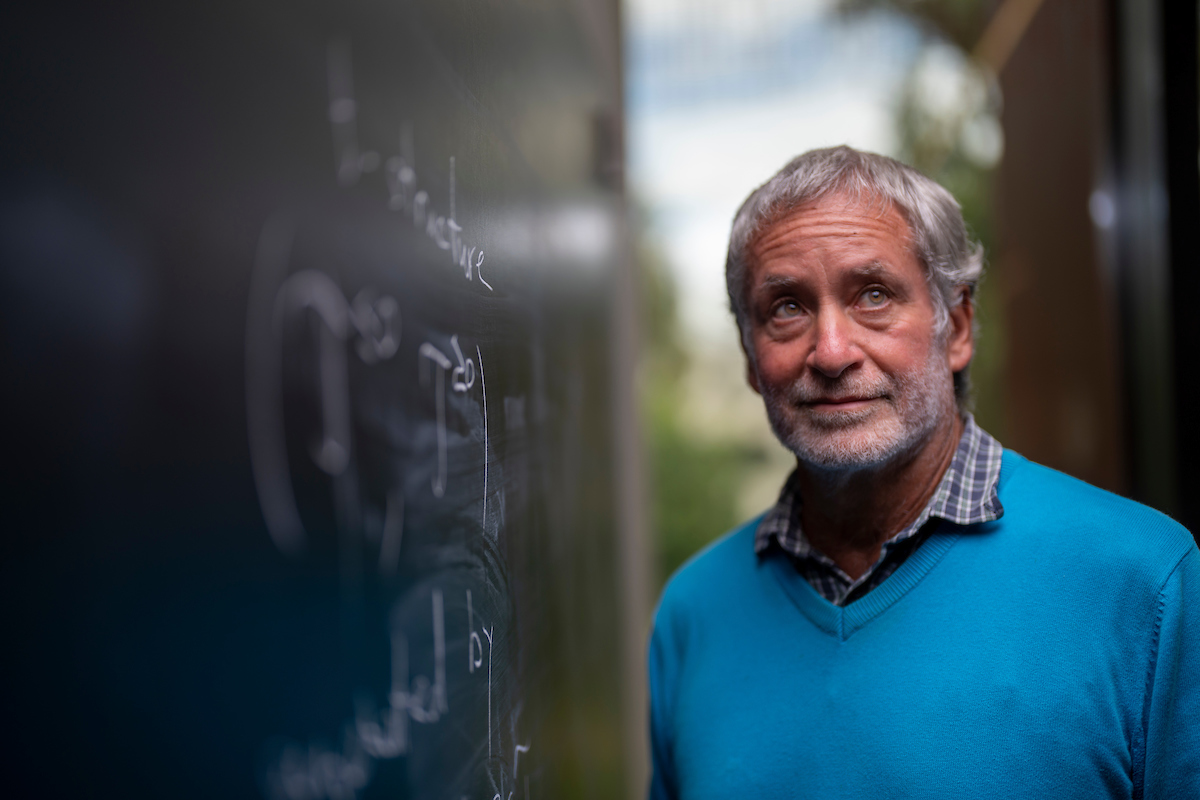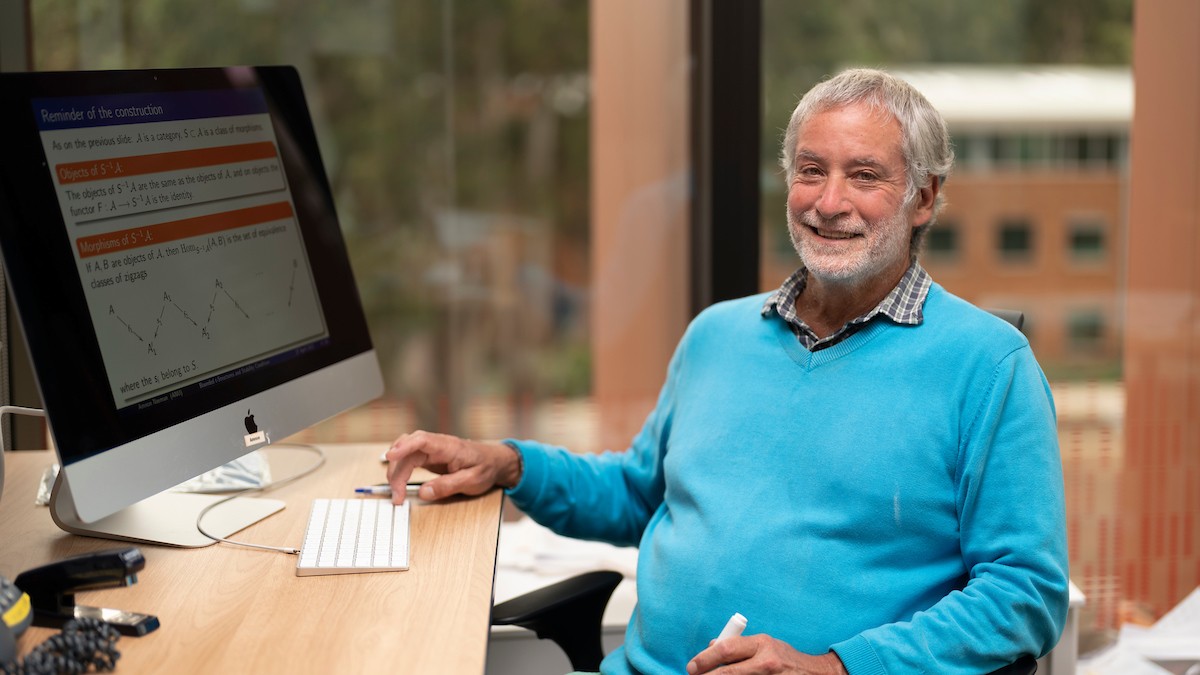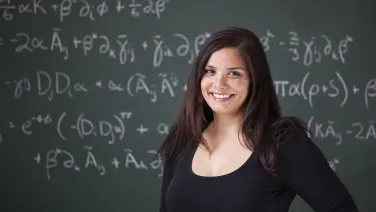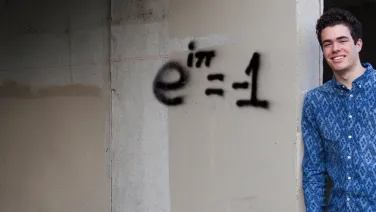Professor Amnon Neeman doesn’t really mind whether you read this story or not

Not long after she was appointed Director of the Mathematical Sciences Institute at ANU, Professor Lilia Ferrario called an all-staff meeting. Addressing the gathered mathematicians, she asked if anyone had any research findings she could promote to the media. It can be difficult for maths news to make the headlines unless there’s a concerted push. Even then, it’s still difficult.
In answer to Professor Ferrario’s question, one of the mathematicians coyly pointed in the direction of his colleague, Professor Amnon Neeman.
Reluctantly, Professor Neeman admitted that, yes, he might be able to contribute some news of interest. You’ll soon see that Professor Neeman is prone to understatement.
Six months earlier he had a paper published in the highly prestigious Annals of Mathematics. In the paper, Professor Neeman solved two open problems which have, for the past 20 years, thwarted the efforts of the best algebraists in the world.
“I still can’t believe that so few of us knew about this,” Professor Ferrario says, remembering the shock of discovering this information almost by accident. Afterwards, she immediately contacted the College Dean to tell him about Professor Neeman’s achievement.
“This really is,” she wrote, “a very big deal.”
A result like this would be the highlight of any mathematician’s career, Associate Professor Jim Borger tells me. He works with Professor Neeman at ANU and says publication in the Annals, along with Professor Neeman’s invitation to the exclusive International Congress of Mathematicians, is recognition of “the highest level, internationally, of pure mathematics research.”
Associate Professor Borger says that if he were to achieve a similar result, he imagines he would be “bursting with pride”.
So why isn’t Professor Neeman shouting from the rooftops about his accomplishment? If a mathematician solves a problem—one as famous and difficult as this—and yet doesn’t even care if anyone knows about it, then what is he actually doing it for?
And why should we care about it - at all?

Professor Neeman’s paper was submitted to the Annals of Mathematics in 2017. It took four years for it to be refereed and checked for errors, which is apparently normal for a paper of its length and significance. The title of the paper is Strong generators in Dperf (X) and Dbcoh(X).
The way Professor Amnon explains his finding is like this: In the early 2000s, some mathematicians proved some results which turned out to be strikingly useful to many other mathematicians, generating an enormous number of papers.
But these results had limitations in how they could be applied. Mathematicians knew it should be possible to overcome these limitations, but they didn’t know how to prove this. Professor Amnon developed a technique which proved it.
“Somehow,” Professor Neeman says, “mine was a qualitatively better result than anyone managed.”
Professor Neeman chooses his words carefully and says “somehow” a lot. We both know that he knows exactly how but, somehow, he takes being low-key to an even lower key.
He also says that in his 40-year career, this is the first time he’s ever been asked to do an interview.
“This certainly is a new experience for me,” he says.
Professor Neeman is 64 years old. Rightly or wrongly, there is an assumption that mathematics favours the young. “A mathematician may still be competent enough at 60,” the British mathematician G. H. Hardy wrote in 1940, when he was over 60 himself, “but it is useless to expect him to have original ideas.”
And yet Professor Neeman had an original idea. And, as seems to be the case with many breakthroughs, it came to him when he wasn’t looking for it.
“I happened to be in the right place at the right time.”
It started while he was in the process of refereeing a paper by the Russian mathematician Dmitri Orlov for the Annals. In Orlov’s paper, Professor Neeman saw a new idea which could be combined with an old idea he recalled from an obscure paper by the Australian mathematician Max Kelly. That’s one of the benefits of a long career, he says: “You know things.”
When considered together, the two ideas could offer a way forward to proving the decades-old problem. This was new mathematics.
“Was there a eureka moment?” I ask because I want to hear about the eureka moment.
“It was a serendipity,” he replies because he doesn’t want to describe it the way I want him to. “There was a moment of realisation that this could be applied successfully to the problem, but then there was months of hard work to check it.”
“But,” I coax, “wasn’t that moment of realisation really satisfying?” After all, this is a very big deal.
“On the rare occasions when you have an idea and it turns out to work, it is a very satisfying feeling,” Professor Neeman admits, cautiously. “Every now and then, we are lucky.”
His colleague, Associate Professor Borger, says this is typical of Professor Neeman’s modesty. “He’s downplaying it,” he tells me. “Okay, in some sense he got lucky, but you have to prepare the ground for luck to strike. No-one else in the world got lucky.”

Professor Neeman isn’t good at self-promotion. Unlike Professor Ferrario, I am not surprised, at all, that no-one knew about his achievement.
On the subject of receiving recognition for his success, he says, “The community of mathematicians who understand and care about the kind of work I do is large enough.”
But it’s my job to promote his work to a larger community. I tell Professor Neeman that I’m going to try to do this, even though, no matter how hard I tried, I could never understand the maths.
He replies, “No, no, no, you’re doing yourself an injustice. You could.”
I really couldn’t. No offence to you, but you probably couldn’t either. This is one reason why it’s hard for a breakthrough in pure maths to make the news.
The other reason is that such breakthroughs usually have no practical application outside the discipline. If there’s one thing I’ve learned from the comments on our Science at ANU Facebook page, it’s that research that is perceived to have “no point” makes people really angry.
Professor Neeman’s finding has little, if any, practical value. That is “the point” of pure maths. There are mathematicians who make a career out of using applied maths to answer real-world questions but, Professor Neeman says, “I am not one of them.” He says it is typical for a pure mathematician like himself to spend a career publishing papers without any indication of whether people are reading them.
Would I still write this story if I knew that no-one would read it? Is something only worth doing if there’s a witness to impress? I imagine a violinist, alone in their room, happy to play without an audience. What’s the point?
I ask Professor Neeman: “So why do you do it?”
“Because,” he replies, “I want to know the answer.”
He likes to be engrossed by difficult problems, he says, the kind that other people might dismiss as beyond their reach. When he was younger, he would work almost non-stop, only sleeping for two hours a night. Now, a problem will work away in his mind as he plays with his grandson, or when he walks on Mount Ainslie, looking at the kangaroos.
“Somehow a problem doesn’t leave you, and it can be like that for months.”
“To tell you the truth,” he continues, “I find it calming. When I am in one of these phases, when I’m really completely absorbed by a problem, it takes my mind off other things. The world is a difficult place, right? I read about the climate crisis, and about hospitals being full of COVID patients. It’s better to try to see if I can solve my problem.”
His memory isn’t what it used to be—“at my advanced age”—so now he writes down each idea as it comes to him, immediately. But because he prefers to tackle only difficult problems, most of his ideas, he says, “turn out to be duds.”
I ask him to confirm this: that most of his ideas don’t pan out. Would I still write this story if I knew, even after all my drafts, it would likely end up in the trash folder, a wasted effort? Would you bother to even try to solve a puzzle if there was a high chance it wasn’t actually solvable?
“Most of the time, we have ideas and, let’s face it, they don’t work,” he says. “But we just have to keep on going. And someday, something will work out.”
For Professor Neeman, pleasure comes, simply, from the doing. He sits down to a problem, and maybe he can find the answer, or maybe not. Either way, the result is the same: he will move on to another problem.
There’s more to that comparison with the violinist. Neuroscientists have found that the same parts of the brain used to appreciate beautiful art and music are activated in the brains of mathematicians when they see “beautiful” maths.
When I look at Professor Neeman’s paper, nothing happens in my medial orbito-frontal cortex. There’s no point, no beauty, for me. But isn’t there still something in it? Isn’t there some beauty in a person working away on an idea, not for the glory, but because some day, something will work out?
“He’s working at the very frontiers of knowledge,” Associate Professor Borger says of Professor Neeman. His paper will contribute to the work of others including, possibly, applied mathematicians. Plenty of pure maths has laid the foundations for future technological advances and improvements in our standards of living. It just takes time, and as Professor Neeman notes, he might not live long enough to see it.
“Maybe a young mathematician will sit down to read my paper. Then they might well have a moment like I had with Orlov’s paper where they think, ‘Yeah, I can use this.’”
It’s his legacy, I suggest to him, and he considers it. I think “legacy” sounds to him like too lofty a word.
“If you’ve had a good idea,” he proffers, “then you’d like it to have a life.”
And I don’t understand maths, but I like the sound of that: giving life to good ideas. That sounds like something worth caring about.
The ANU Bachelor of Mathematical Sciences is an elite, research-focused program for students who love trying to solve problems – even ones that might not have solutions.



